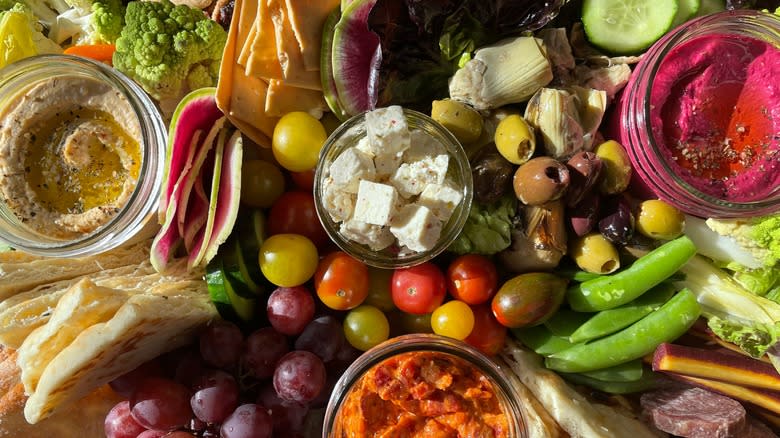Charcuterie Board Vs. Crudités Platter: What's The Difference?

Charcuterie boards and crudités platters are two dishes that you're probably used to seeing on appetizer menus or being served at cocktail parties. They're both delicious ways to start a meal (or keep guests from getting too boozy during cocktail hour) because they consist of an array of bite-sized foods that pair well together, like cheese and olives or carrots and hummus. It's easy to confuse the two, which is why we're here to explain the difference.
A charcuterie board is primarily made up of meats accompanied by cheese, crackers, and other ingredients like nuts or spreads. Meanwhile, crudités is essentially a fancy word for a vegetable platter that has raw vegetables like carrots and tomatoes paired with complimentary dips. You might have some sort of vegetable on a charcuterie board, or a cheese dip on a crudités platter, but the cores of these dishes are split between meats and veggies.
Read more: 23 Spring Fruits And Vegetables, Explained
The Elements Of A Charcuterie Board

Most of us are relatively familiar with charcuterie boards, especially because they've gone viral on social media in recent years, but these delicious trays of meat and cheese predate TikTok. The practice started back in 15th-century France as a sales tactic for stores that specialized in cured pork products. When translated directly from French to English, the word "charcuterie" means "cold cuts."
These days, charcuterie boards are, arguably, more popular than ever. One of the perks of charcuterie boards is that they can be customized with pretty much anything you want, but here are the core ingredients: Cured meats like prosciutto or salami, cheeses like Brie or Gruyere, crackers or toasted bread, nuts like almonds, and spreads like jam. You can research and pair those ingredients with others that complement each other, like the creaminess of Brie with the sweetness of grapes or figs. Any vegetables on your board are meant to complement the meats and cheeses, unlike crudités, where veggies are the star of the dish.
How Crudités Platters Are Different

The vegetable trays of broccoli and ranch dip you've been served at parties are not far from crudités platters. Like charcuterie, crudités also has French roots. The word crudité translates to rawness, and when an "s" is added, it refers to vegetables that are eaten raw. And, therein lies the key difference between crudités and charcuterie. In crudités, the vegetables and other ingredients are raw, whereas charcuterie features cured and prepared ingredients. The key to a delicious crudités board is a variety of the freshest vegetables possible.
Sometimes, you might want to blanch certain vegetables due to their toughness, such as broccoli. However, keeping everything raw is key to an authentic crudités platter. The most common vegetables include celery, carrots, cucumbers, radishes, asparagus, and bell peppers. You can also use marinated artichoke hearts or olives for a bit of saltiness, which are two of the only ingredients that occasionally overlap with a charcuterie board. Instead of slices and hunks of cheese like a charcuterie board, these vegetables are served with dips and spreads like hummus, tzatziki, or cheese dips like whipped feta.
Read the original article on Tasting Table.

